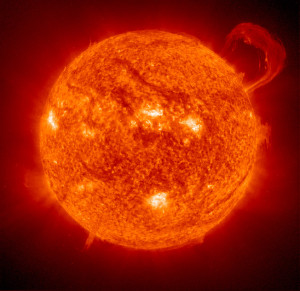Sep 4 2015
Researchers from Berkeley Lab and the University of Illinois have successfully integrated designer quantum dot light-emitters with spectrally matched photonic mirrors to produce solar cells capable of absorbing blue photons at concentration about 30 times greater than that of traditional solar cells. This is the first time such high levels of luminescent concentration factor have been recorded.
 Bathing the Earth with enough energy in one hour to meet human needs for an entire year, the sun represents the ultimate source of clean, green sustainable energy.
Bathing the Earth with enough energy in one hour to meet human needs for an entire year, the sun represents the ultimate source of clean, green sustainable energy.
This research is likely to enable the future progress of inexpensive solar cells capable of efficiently consuming the solar spectrum’s high-energy portion.
“We’ve achieved a luminescent concentration ratio greater than 30 with an optical efficiency of 82-percent for blue photons,” says Berkeley Lab director Paul Alivisatos, who is also the Samsung Distinguished Professor of Nanoscience and Nanotechnology at the University of California Berkeley, and director of the Kavli Energy Nanoscience Institute (ENSI), was the co-leader of this research. “To the best of our knowledge, this is the highest luminescent concentration factor in literature to date.”
The corresponding authors of a paper in ACS Photonics titled “Quantum Dot Luminescent Concentrator Cavity Exhibiting 30-fold Concentration” are Alivisatos and Ralph Nuzzo of the University of Illinois. One of three lead authors along with Yuan Yao and Lu Xu is Noah Bronstein, a member of Alivisatos’s research groups. Other co-authors are Erin O’Brien, Alexander Powers and Vivian Ferry.
According to the U.S. Department of Energy (DOE) reports, the US solar energy sector is growing with the number of photovoltaic installations producing 1.2GW of electricity in 2008 to 20-plus gigawatts this year. However, fossil fuels are still used to generate about 70% of the electricity in the US.
In order to realize the massive benefits of solar power, inexpensive photovoltaic solar panels have to replace currently used ones. Luminescent solar concentrators (LSCs) seem to be a probable alternate solution. The traditional solar cells absorb sunlight directly and convert it into electricity. The LSCs however work differently. The sunlight is absorbed onto a plate embedded with highly efficient light-emitters called “lumophores”. These lumophores then re-emit the absorbed sunlight at longer wavelengths, a process referred to as Stokes shift. The re-emitted light is passed onto a micro-solar cell, which converts it into electricity. The amount of solar energy striking the cell is very concentrated as the plate in the LSC is bigger than the micro-solar cell.
As the concentration is adequate, only limited quantity of expensive III−V photovoltaic materials are required for collecting light from an inexpensive luminescent waveguide. But the collection efficiency and concentration factor of the molecular dyes that have been used as lumophores until now are inadequate due to parasitic losses such as imperfect light trapping within the waveguide, non-unity quantum yields of the lumophores and reabsorption and scattering of propagating photons.
“We replaced the molecular dyes in previous LSC systems with core/shell nanoparticles composed of cadmium selenide (CdSe) cores and cadmium sulfide (CdS) shells that increase the Stokes shift while reducing photon re-absorption,” says Bronstein.
“The CdSe/CdS nanoparticles enabled us to decouple absorption from emission energy and volume, which in turn allowed us to balance absorption and scattering to obtain the optimum nanoparticle,” he says. “Our use of photonic mirrors that are carefully matched to the narrow bandwidth of our quantum dot lumophores allowed us to achieve waveguide efficiency exceeding the limit imposed by total internal reflection.”
In their ACS Photonics paper, the team conveys the belief that LSC devices in the future will be able to realize even higher concentration ratios because of the modifications to the waveguide geometry, luminescence quantum yield and photonic mirror design.
A new solar concentrator project partnership was formed between Berkeley Lab, the University of Illinois, Caltech and the National Renewable Energy Lab (NREL) after the successful accomplishment of the CdSe/CdS nanoparticle-based LSC system.
At a recent Clean Energy Summit in Las Vegas, President Obama and Energy Secretary Ernest Moniz announced that this research partnership will be awarded a $3 million grant to develop a micro-optical tandem LCS under Micro-scale Optimized Solar-cell Arrays with Integrated Concentration (MOSAIC), the latest program from DOE’s ARPA-E.
The LCS research reported in this story was carried out through the U.S. Department of Energy’s Energy Frontier Research Center program and the National Science Foundation.